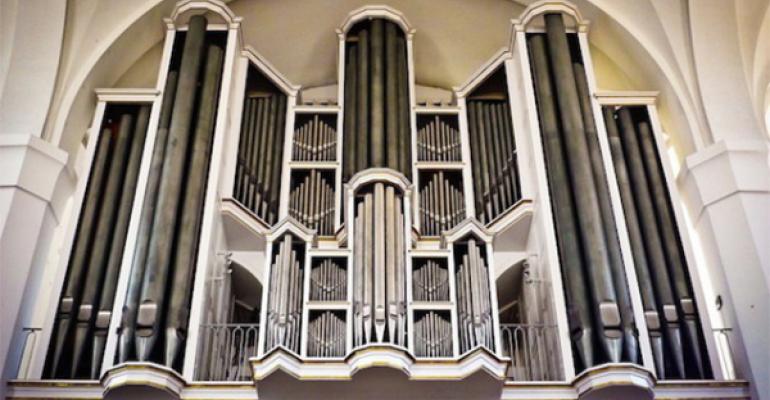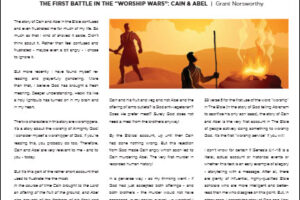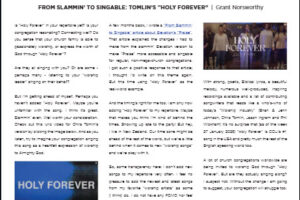Take this link to read Grant’s article as featured in the March issue of Worship…

GOOD LOUD AND BAD LOUD
By Grant Norsworthy
When I was a kid growing up in the Church, music for the Sunday morning services primarily used organ for instrumental accompaniment.
This electronic organ was top of the line, and played by a pro. While it wasn’t a cathedral-style pipe organ, it was the best available instrument to replicate that sound. The organ had a dedicated sound system with multiple, huge, high quality speaker enclosures suspended around the auditorium. They could fill the whole room with rich, full sound. In those moments when the organ was really cranking, it created a formidable sonic experience. My memory was of a sound that I could feel on my skin as well as hear with my ears. I loved it. Everyone loved it. Especially the older people.
Back in the 80’s, as a keen, music-loving, bass playing teenager, I tried to introduce a more contemporary style of music to the once-a-month, evening youth service. Some friends and I formed a band using drums, bass, electric guitar, a keyboard, singers and a few brass players.
But our sound was whatever we were making from the “stage”, augmented by the vocals going through two tiny public address speakers attached to the ceiling. These had been installed with only the projection of a single preacher’s voice in mind – not a band like ours. As beginners through such an inadequate sound system, we must have sounded pretty terrible.
We got a lot of complaints – especially from older people. And the complaint we heard the most was that we were just “too loud’.
Being young and inexperienced, I didn’t really know how to process the criticism. But I was sure we were not – could not be – as loud as the organ. And so, the idea of “good loud” and “bad loud” first began to form in my mind.
Good loud is full and powerful but well-rounded. Good loud shifts some serious air in the low end of the frequency spectrum, but is never aggressive in the high-middle to high frequencies. Too much level in those higher frequencies is sure to make loud turn bad. They are the frequencies that are most likely to cause irritation, pain and (in extreme cases) potential permanent hearing loss.
While I sometimes like loud music – louder and probably more often than most people – I never like loud music that’s harsh on my ears.
You can feel good loud against your skin and still have your ears enjoying the experience. Good loud draws people’s attention and invites them to connect. Bad loud has the opposite effect. Bad loud is aggravating, gives a horrible experience and can cause harm. It pushes people away. I don’t ever want to have music – or any other sound – annoy me, cause me physical pain or (any more) permanent hearing loss.
I have heard too much bad loud throughout my life. Some self inflicted. Some not. I have the constant ringing in my ears to prove it. I do not wish that on anybody.
A cheap guitar amp with too much gain, a crash cymbal or a snare drum played with ill-judged intensity or (heaven forbid!) feedback are more likely to make a listener feel discomfort than lower frequencies. These harsh, biting sounds are characteristics of bad loud and will be more likely to draw complaints from people feeling like the music is too loud for them.
Of course, people have their different, subjective tastes for music volume. If someone thinks the music is too loud and you don’t, they’re not wrong and you’re not right. You may just have different preferences.
But if the loud is bad loud, that’s far less subjective. If it’s harsh and causing irritation (or worse) to anybody that’s being asked to listen, it is too loud.
While I am not an advocate for the “If it’s too loud, you’re too old!” motto, there is a certain truth to it. Generally (and medically) speaking, older people are more sensitive when it comes to loud, harsh sounds than younger people. An appropriate level to youths, might be causing physical pain to the grey hairs!
That said, if I don’t like the performance or the type of music, I don’t like it at any volume. The louder it is, the more I will dislike it. Sometimes people use the descriptor “It’s too loud” when what they mean is, “I don’t like this music at any level that I can hear.”
And out of a lack of vocabulary and/or technical expertise, a person may describe music as being “too loud” when actually, it’s not the overall decibel (dB) level that’s the problem. Actually the sound could be harsh, biting, aggressive sounding. It just plain sounds bad to them.
Good loud is more easily achieved in smaller spaces – smaller rooms with smaller crowds. The bigger the room, the more difficult it will be. Shiny, hard surfaces like glass and tile that bounce sound rather than absorb it, will make the task tougher too.
So, should the music in a Church service ever be loud?
I’d like to think, yes, but it depends on several very important factors:
- The loud should never be bad loud – only good loud.
- The public address (PA) system must be capable of producing good loud.
- The audio engineer operating the PA must be sufficiently (highly) skilled.
- Even if it’s good, loud should not be sustained for too long. Creative use of dynamics with periods of good loud will strengthen the overall musical invitation.
- It should never overwhelm the loudness of the congregation’s singing.
A lot of Church audio engineers are given certain decibel (dB) levels that they must not exceed during a service. But this approach is only helpful to a certain point. A dB meter cannot tell the difference between good loud and bad loud. A human is needed for that. With the skillful application of good loud, the dB limits might be able to be adjusted in the upward direction.
But I don’t say all of this just because I like good loud music. Instead, I sincerely believe that the correct application of good loud offers an important tool that can help God’s people sing! Sing better than many of us are singing now. Sing with some passion! Some abandon! Sing loud!
God created all things, including sound of every level. Good loud can be used for His glory, and as a sincere expression of worship.
This article was first published by Worship Tech Director of the WFX Network on November 10, 2016.


